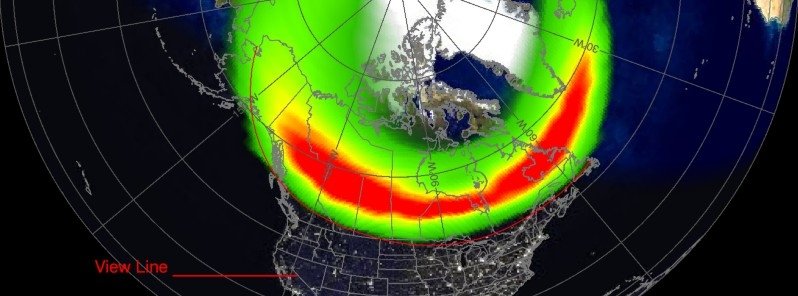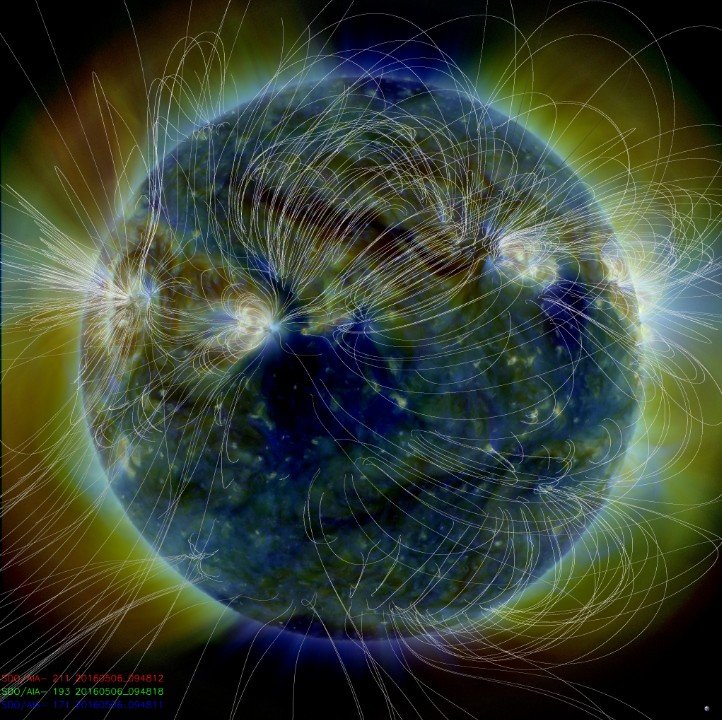
© NOAA/SWPCProbability of visible aurora at 08:05 UTC on May 8, 2016.
Geomagnetic K-index of 5 (G1 - Minor geomagnetic storm) threshold was first reached at 02:25 UTC on May 8. K-index of 6 (G2 - Moderate) threshold was reached just 30 minutes after, at 02:59 UTC. Over the next three hours, conditions further deteriorated and by 05:59 a G3 - Strong geomagnetic storm (K-index of 7) was in progress.
Under G3 - Strong geomagnetic storms, the area of impact is primarily poleward of 50 degrees Geomagnetic Latitude. Power system voltage irregularities are possible, false alarms may be triggered on some protection devices. Spacecraft systems may experience surface charging; increased drag on low Earth-orbit satellites and orientation problems may occur. Intermittent satellite navigation (GPS) problems, including loss-of-lock and increased range error may occur. Radio - HF (high frequency) radio may be intermittent. Aurora may be seen as low as Pennsylvania to Iowa to Oregon
G3 - Strong geomagnetic storm lasted for about 1 hour, until 06:55, when G1 - Minor storm conditions were observed again. This weakening, however, didn't last long.
At 08:07 UTC, observed K-index reached 6 again (G2 - Moderate).
Coronal hole as observed by NASA's SDO (AIA 211/193/171) on May 6, 2016.

© NASACoronal hole as observed by NASA's SDO (AIA 211/193/171) on May 6, 2016.
Space Weather Message Code: ALTK05
Serial Number: 959
Issue Time: 2016 May 08 0228 UTC
ALERT: Geomagnetic K-index of 5
Threshold Reached: 2016 May 08 0225 UTC
Synoptic Period: 0000-0300 UTC
Active Warning: Yes
NOAA Scale: G1 - MinorNOAA Space Weather Scale descriptions can be found at
www.swpc.noaa.gov/noaa-scales-explanation
Potential Impacts: Area of impact primarily poleward of 60 degrees Geomagnetic Latitude.
Induced Currents - Weak power grid fluctuations can occur.
Spacecraft - Minor impact on satellite operations possible.
Aurora - Aurora may be visible at high latitudes, i.e., northern tier of the U.S. such as northern Michigan and Maine.
***
Space Weather Message Code: ALTK06
Serial Number: 401
Issue Time: 2016 May 08 0303 UTC
ALERT: Geomagnetic K-index of 6
Threshold Reached: 2016 May 08 0259 UTC
Synoptic Period: 0000-0300 UTC
Active Warning: Yes
NOAA Scale: G2 - ModerateNOAA Space Weather Scale descriptions can be found at
www.swpc.noaa.gov/noaa-scales-explanation
Potential Impacts: Area of impact primarily poleward of 55 degrees Geomagnetic Latitude.
Induced Currents - Power grid fluctuations can occur. High-latitude power systems may experience voltage alarms.
Spacecraft - Satellite orientation irregularities may occur; increased drag on low Earth-orbit satellites is possible.
Radio - HF (high frequency) radio propagation can fade at higher latitudes.
Aurora - Aurora may be seen as low as New York to Wisconsin to Washington state.
***
Space Weather Message Code: ALTK07
Serial Number: 102
Issue Time: 2016 May 08 0558 UTC
ALERT: Geomagnetic K-index of 7
Threshold Reached: 2016 May 08 0559 UTC
Synoptic Period: 0300-0600 UTC
Active Warning: Yes
NOAA Scale: G3 - Strong
NOAA Space Weather Scale descriptions can be found at
www.swpc.noaa.gov/noaa-scales-explanation
Potential Impacts: Area of impact primarily poleward of 50 degrees Geomagnetic Latitude.
Induced Currents - Power system voltage irregularities possible, false alarms may be triggered on some protection devices.
Spacecraft - Systems may experience surface charging; increased drag on low Earth-orbit satellites and orientation problems may occur.
Navigation - Intermittent satellite navigation (GPS) problems, including loss-of-lock and increased range error may occur.
Radio - HF (high frequency) radio may be intermittent.
Aurora - Aurora may be seen as low as Pennsylvania to Iowa to Oregon.
Consider:
Our solar system past implicates a wandering systems body that impinges upon our system irregularly to disrupt mechanics. Altho we find only implications but no evidence.. What if our sun Sol, experiences a magnetic alignment that produces a magnetic refraction that appears in the sky as a solar shade of our sun? And then Sol would actually be the producer of the ‘thunderbolts of the gods’ that strike the Earth while the magnetic shade ONLY appears to be involved?
This is not so strange as it may at first seem as science regularly relies on the ‘galactic lensing’ phenomena that allows distances to be arbitrarily assigned by science observers.